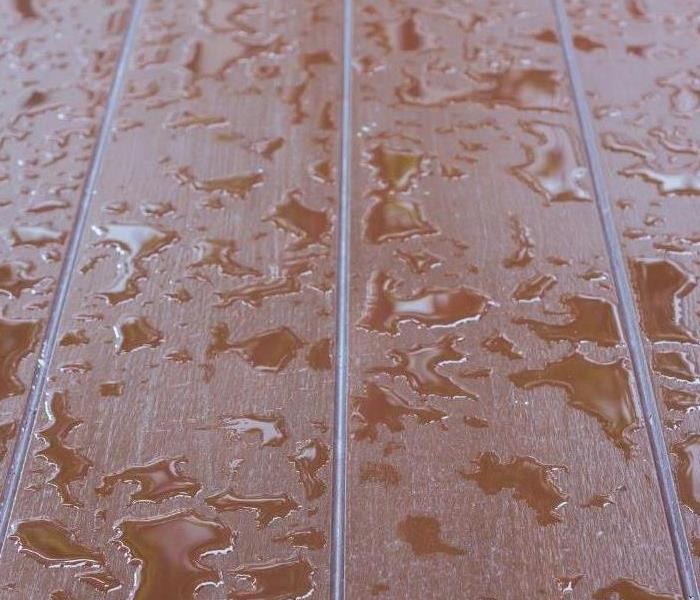How to Handle Water-Damaged Wood Floors
6/2/2020 (Permalink)
REMOVE SURFACE WATER
Removing surface water on water damage wood floors is the first step to saving your floors from the junkyard. The foremost thing you should do, however, is to identify the source of water that is damaging your floors. Check for burst or leaking pipes and holes on your ceilings and roof. You should repair damaged areas in your house to prevent water damage in the future.
When your home has been exposed to water damage your water damaged hardwood floors will have unsightly dark stains. You can restore your floors to looking like new but it will require some elbow grease. You can remove the stains on your floor through the least invasive methods to the more extreme treatments. Stains on wooden floors are a result of water seeping below the polyurethane finish to the wood material.
The first thing you can do for stain removal is to wipe away surface dirt and grime with a damp cloth. After you have cleaned the floor thoroughly apply a steel brush to lightly rub the stained and surrounding areas. The feathering technique will help in future staining and refinishing touches. Apply bleach on heavily stained areas from water damage to lighten the stain.
SCRUB THE FLOOR
Scrubbing the floor is important after water damage to remove mud, silt, and organic material. These substances are pollutants which aid in the formation of mold growth. Mold is unsightly and can cause allergic reactions. The presence of mold will further exacerbate your problems after suffering water damage on your home. Water on a wood floor with its increased moisture can play host to different species of mold. Disinfect your home once and for all by mixing a mild detergent and a compatible disinfectant with clean water in a bucket. Scrub the entire floor thoroughly including baseboards and other woodwork such as stairs and posts with a stiff brush. Avoid pouring more water on the floor because the floor is already saturated.
When you have water damage on your floors you may notice cupping or warping. Water damage to hardwood floors buckling should be prevented because it could spread to the rest of your floor area. When water damage occurs in your home you should do your best to dry the area thoroughly using air movers and humidifiers. Wood that is dried too fast tends to get warped and cracked so you must take care to control the temperature.
DRY THE FLOOR
You should dry wooden floors at a constant temperature to bring back its former look. The first step on how to dry out hardwood floors after a flood is to keep fans and air movers on the area. Open windows and doors unless the outdoor air is more humid than the indoor air. A good tip on drying hardwood floors water damage is to dry the floor steadily and slowly. Apply cross ventilation by getting a box fan on a large window so the fan blows out, then, open windows on the opposites side to let fresh air in. This method is also a great way on how to dry water under the wood floor.
REPLACE LAMINATE
Laminate is an often-used material on homes but it is different from hardwood although it may look like one. The laminate flooring material is made up of wood pulp in the fashion of particle boards and sometimes MDF or medium-density fiberboard. Laminate flooded floors get destroyed easily and may need to be replaced. Floors made from laminate are highly sensitive to water damage and swells when it gets soaked which ruins the material entirely. It is important to replace laminate flooring immediately because it will only be a host to mold and mildew. As a precaution, do not use laminate flooring near areas where water damage may happen. These areas include bathrooms, kitchens, and basements. Flooring on these areas must be made of flood floorings resistant materials such as tiles or marble.
CONCLUSION
Water damage can cause you headaches but repairing wood floors water damage is possible. Water spill on a hardwood floor is easiest to rectify and you will only need to scrub the stained area with a steel brush. Wooden floors that have warped however due to extensive water damage to wood floors buckling may need to be replaced. Hardwood is resilient and the question- does water damage hardwood floors– depends on the extent of water damage. If the wood has been sitting on water for long periods it may have rotted and warped and need to be replaced. All in all, you have to apply elbow grease to save your wooden floors. The question of can water damaged hardwood floors be repaired—depends on your willingness to act fast and mitigate the damage by applying your own effort or getting professional assistance. When in doubt call SERVPRO of Salem/Peabody/Marblehead and our team of professionals will assess your floor damage for you. 978.744.4545






 24/7 Emergency Service
24/7 Emergency Service
